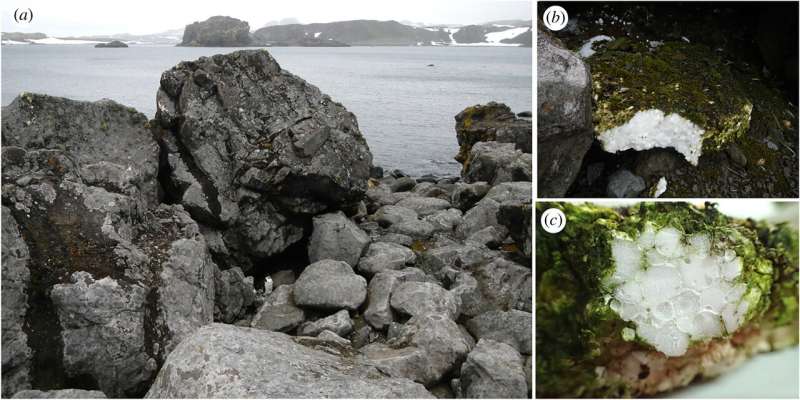June 24, 2020 report
Microplastics found in gut of remote Antarctic hexapod

A team of researchers from the University of Siena, University College Dublin and Elettra–Sincrotrone Trieste, have found evidence of microplastics in the guts of remote Antarctic hexapods. In their paper published in the journal Biology Letters, the group describes where the hexapods were found, how they were tested and what they learned.
Hexapods are invertebrate creatures that resemble insects but have internal mouthparts. The hexapods studied by the researchers were Cryptopygus antarcticusm, commonly known as springtail. The creatures are small, just a millimeter in length, and live in the soil. They feed on moss, algae and lichen. The specimens found by the researchers were living on a piece of polystyrene foam that had washed up on a beach on King George Island, which is just north of Antarctica and approximately 100 miles south of the southern tip of South America. The researchers brought the samples back to their lab in Italy and tested then to find out if they might have been adversely impacted by the polystyrene.
The team studied the tiny creatures using infrared spectroscopy, which allowed them to peer into the digestive system. They were able to see small bits of plastics inside of the creatures. The researchers suggest the plastics were likely first ingested by the moss, algae and lichen on the piece of polystyrene, which were then subsequently consumed by the springtail. The researchers claim their finding is the first evidence of microplastics inside of a terrestrial animal in the Antarctic and that it represents one of the most remote instances of an animal ingesting man-made materials. They also suggest that plastics are entering the Antarctic food chain, and are thus introducing another stressor to the ecosystem in a region already responding to global warming and other human activities such as research efforts, military operations and tourism.
The researchers also note that despite their small size, springtail are considered to be one of the dominant terrestrial species in the Antarctic in areas that are not covered in ice. If they become threatened by microplastics, the impact on the region could be dramatic; their loss would be felt all the way up the food chain to larger animals such as penguins and seals.
More information: Elisa Bergami et al. Plastics everywhere: first evidence of polystyrene fragments inside the common Antarctic collembolan Cryptopygus antarcticus, Biology Letters (2020). DOI: 10.1098/rsbl.2020.0093
Journal information: Biology Letters
© 2020 Science X Network




















